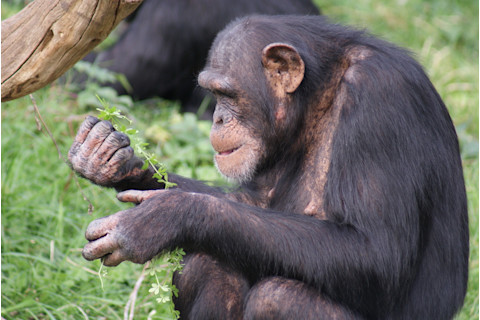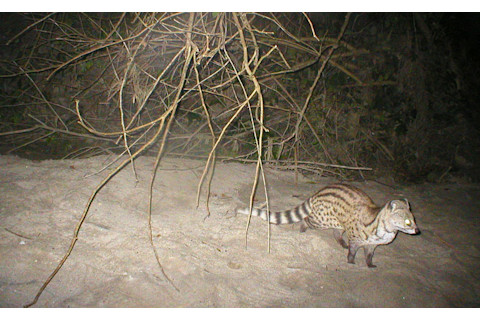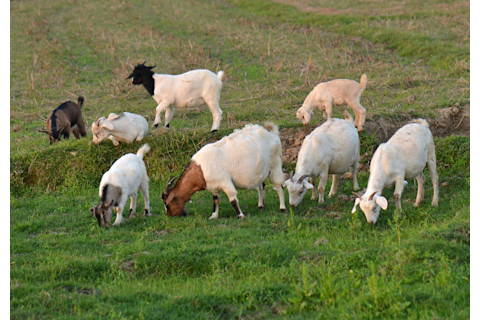
When we fall ill we visit a clinic or a pharmacy. Our ancestors, however, didn't have that luxury. Instead, early humans likely observed and learned from sick animals that healed themselves by eating certain plants. Yet, only in the past two decades have biologists and chemists begun to recognize that animals do self-medicate – select and use substances specifically to cure themselves of parasites and ailments. Early accounts of animal self-medication came in the late 1980s from Michael Huffman, a primatologist at Kyoto University. His decades-long research on chimpanzees, which revealed that they use plant compounds to rid themselves of parasites, helped established self-medication as a fundamental animal behavior. “Any animal species alive today is alive in part because of its ability to adapt and to fight off diseases,” Huffman says. Self-medication does not require high intelligence, but was simply the reaction of animals to remove an ailing symptom that evolved into strategies to expel parasites. “Self-medication is a very basic behavior that’s important to the survival of so many species,” he says. And animal self-medication points to a treasure larger than mere fascination. By following the animals’ lead, we tap into a medicine vault furnished by millions of years of natural selection. The world's best bio-prospectors – the animals themselves – may very well show us new pharmaceuticals to improve the health of our livestock and ourselves.

Image by poeticpenguin/Shutterstock
Nature's Medicine
In 1987, Huffman was observing chimpanzees in Mahale Mountain National Park, Tanzania, when he noticed a sick chimpanzee acting strangely. That chimpanzee peeled the bark off branches of a small tree, chewed the pith within and sucked out the juices. The tree was Vernonia amygdalina, a poisonous plant known in English as bitter leaf and sometimes locally referred to as ‘kill goats.’ “It's not something you want to play with,” Huffman warns. Why was the sick chimp chewing on the bitter pith of this poisonous plant? Huffman and his colleagues showed that chimpanzees that chewed the pith often had higher parasite loads than other chimpanzees. They also found that compounds from bitter pith strongly suppress the parasitic nematode Oesophagostomum stephanostomum, a gastrointestinal parasite that can be deadly to chimpanzees. Huffman found 88 percent fewer of the nematode's eggs in the feces of a wild chimpanzee about twenty hours after the chimp chewed bitter pith. Inspired by this discovery, new bioactive compounds were subsequently identified in the bitter pith of V. amygdalina, many of which suppress amoeba, tumors and bacteria. African tribes have long used the plant to remove intestinal parasites and treat disease – and now researchers are realizing its benefits too. Clinical trials in recent years have found that V. amygdalina can prevent cancer and may help treat malaria.

Image by Nandini Velho, Pakke Tiger Reserve
Colon Cleanse
The Chinese lesser civet eats everything from insects and small animals to fruits and eggs. Still, scientists led by Hsiu-Hui Su (National Pingtung University of Science and Technology, Taiwan) were puzzled when they examined the feces of wild civets and found bundles of intact leaves, folded and stacked into tens of layers. The civets apparently swallowed the leaves without chewing. Prying open the leaf bundles, the scientists found hints that could explain leaf-swallowing by civets: live, parasitic adult worms were caught in the folds of the leaves. Gastrointestinal nematodes are likely a common pain among animal species. In response, various animals have evolved similar tactics to rid themselves of the worms. One such tactic is to swallow leaves whole and let the leaf masses sweep through the gastrointestinal tract, catching some of the parasitic worms along the way and expelling them with the feces. Great apes (including the chimpanzees observed by Huffman in Africa) swallow leaves, as do snow geese, brown bears and gibbons. The animals use plants specific to their habitats, but they always select rough, hairy leaves which might better trap the worms.

Image by sevenke / Shutterstock
Tannin Treatment
Grazing animals practice admirable sanitation. For example, horses grazing in a crowded pasture establish a 'toilet' – an area restricted for defecation. Such sanitation helps these animals as they easily pick up parasites with every mouth of fresh grass. Some grazing animals, however, have taken to medicating themselves with tannins (a familiar flavor component of red wine) when they are parasitized by gastrointestinal nematodes. For example, parasitized goat kids of the Mamber breed in the Middle East have been observed eating more of the tannin-rich shrub Pistacia lentiscus, a plant the goats normally shun. Feeding on P. lentiscus reduces the nematode egg counts in the goats’ feces to negligible levels. In a separate experiment, lambs infected with gastrointestinal nematodes tasted and ate more of a tannin-supplement that scientists provided. The supplement offered very little nutrition, but the lambs that ingested the tannins successfully relieved their infection levels. After three weeks, when infection levels had subsided, the lambs’ preference for tannins also stopped. Such self-medication could prove helpful for farmers. Scientists are now studying the possibility of providing livestock with medicinal foliage to allow them to medicate as and when needed – which could reduce farmers’ reliance on deworming drugs.

Image by Sylvie Bouchard / Shutterstock
Alcohol Diet
Most parents wouldn’t feed their babies foods laced with alcohol, but fruit fly Drosophilamelanogaster mothers have no qualms – especially if it protects their babies from parasites. Parasitic wasps hunt for Drosophila maggots, eager to plant their eggs into the maggot. The maggots however, can beat the parasitoids with a little alcohol. Parasitized maggots on a 6%-alcohol diet have been shown to survive much better than those on non-alcoholic diets. In the wild, maggots that are parasitized seek out rotting fruits with higher alcohol levels. And what’s more, mother fruit flies can anticipate infection and medicate her babies in advance. Studies have found that when wasps are around, flies prefer to lay their eggs in a substrate enriched with 9-15% alcohol; otherwise, the mother opts for 3% alcohol. A competent mother fruit fly, it seems, knows when to provide her children with an alcoholic childhood. Todd Schlenke, visiting assistant professor at Reed College, Oregon, suspects we will discover more animals using alcohol as medicine. “You can find lots of smaller organisms (like insects) in rotting fruit, and lots of larger organisms (like mammals) that consume rotting fruit,” he says. “So it would be surprising if fruit flies were the only ones using it as part of a defense mechanism.”
Top image by Pressmaster/ Shutterstock













